Here we are providing Class 11 Biology Important Extra Questions and Answers Chapter 3 Plant Kingdom. Important Questions for Class 11 Biology are the best resource for students which helps in Class 11 board exams.
Class 11 Biology Chapter 3 Important Extra Questions Plant Kingdom
Plant Kingdom Important Extra Questions Very Short Answer Type
Question 1.
Define pyrenoid.
Answer:
Pyrenoid is a starch storing organelle present in green algae.
Question 2.
Define ramenta.
Answer:
The hair-like structure present on the younger stem, petiole, and rachis of mature leaves is known as ramenta.
Question 3.
What is the function of mucilage in aquatic plants?
Answer:
Mucilage protects the algae from epiphytic growth and the decaying effect of water.
Question 4.
How much water can Sphagnum absorb?
Answer:
Sphagnum can absorb water up to 18 times its weight.
Question 5.
What is the function of air vesicles in brown algae?
Answer:
The air vesicles in brown algae maintain buoyancy.
Question 6.
Why is Adiantum called a ‘walking fern’?
Answer:
Adiantum is known as ‘walking fern’ because the leaf tips come in contact with the soil, They strike adventitious roots and develop into a new plant.
Question 7.
Give one example of the monocarpic plant.
Answer:
Bamboo.
Question 8.
What are sori?
Answer:
They are groups of separation found in Dryopteris fern.
Question 9.
What are rhizoids?
Answer:
They are slender unicellular or multicellular hair-like structures that penetrate in the moist soil and absorb the water for the plants.
Question 10.
Which pigments are found in green algae?
Answer:
Chlorophyll ‘a’ and ‘b’ and ‘Beta’ carotene.
Question 11.
Define a fruit.
Answer:
Fruit is a developed ovary of the flower that encloses seeds and may be associated with other parts of the flower.
Question 12.
Name the group of vascular plants with naked seed.
Answer:
Gymnosperms.
Question 13.
Name the green algae used as food.
Answer:
Chlorella, Ulva.
Question 14.
Name the following:
(i) Photosynthetic pigments of brown algae
Answer:
Chlorophyll a and c and fucoxanthin,
(ii) Unicellular, biflagellate, pear-shaped green algae.
Answer:
Chlamydomonas,
Question 15.
What are coralloid roots?
Answer:
Coralloid roots are irregular, negatively geotropic,
Question 16.
What is triple fusion?
Answer:
The fusion of the diploid secondary nucleus and one male gamete is called triple fusion.
Question 17.
Define a seed.
Answer:
It is a ripened ovule and capable of forming a new plant.
Question 18.
Define a fruit.
Answer:
Fruit is a ripened ovary.
Question 19.
Give one example of a dicot seed and one of a monocot seed.
Answer:
Dicot: Gram, Monocot: Maize Grain.
Plant Kingdom Biology Important Extra Questions Short Answer Type
Question 1.
Why are red algae able to survive in the deep-sea?
Answer:
Red algae contain phycoerythrin and phycocyanin pigments. Phycoerythrin is able to absorb the blue wavelengths of light and thus can photosynthesize. Since red algae can utilize blue and green rays they can live at greater depths.
Question 2.
What are the features that have led to the success and dominance of vascular plants?
Answer:
- Development of deep penetrating roots to anchor the plant in soil and absorb water and minerals for the plants from the deeper layers of the soil.
- Development of cutin as a waterproof layer on leaves to reduce transpiration.
- Development of mechanical tissue to provide support.
- Development of a well developed vascular system.
Question 3.
Define monopodial growth?
Answer:
When the main axis of the trunk rises straight from the base and reaches up to the tip, this type of growth is known as monopodial growth.
Question 4.
Why do marine algae have no mechanical tissue?
Answer:
Marine algae have no mechanical tissue because buoyancy holds them erect under the sea surface.^
Question 5.
Explain the different types of sexual reproduction in green algae.
Answer:
Sexual reproduction in green algae can be of three different types:
- Isogamy: Both the fusing gametes are morphologically and physiologically similar.
- Anisogamy: The fusing gametes are structurally similar but differ in size and behaviour.
- Oogamy: The female gamete is bigger, food-laden and non-motile, whereas the male gamete is smaller, without food reserve and motile.
Question 6.
Why are seed plants considered the most successful land plants?
Answer:
Seed plant is considered as the most successful land plants because:
- Fertilization is not water-dependent.
- Seed enclosing the future embryo is well protected within the ovary.
- The extensive root system for anchoring and absorption of water.
- Well developed mechanical tissue
- Formation of bark during secondary growth for protection.
Question 7.
Give one example of each
(i) Liverworts
Answer:
Riccia
(ii) Mosses
Answer:
Funaria
(iii) A pteridophyte having bipinnate leaves.
Answer:
Dryopteris
(iv) A pteridophyte having Unipinnate leaves.
Answer:
Adiantum caudatum
Question 8.
Give five distinguishing characteristics of red algae.
Answer:
Five distinguishing characteristics of red algae are:
- Most of the red algae are marine.
- The motile stage is absent in the life cycle.
- The plant body varies from unicellular filamentous to parenchymatous form.
- The cell wall possesses cellulose and hydrocolloids.
- Photosynthetic pigments include chlorophyll a, carotenoids and phycobilins.
Question 9.
Discuss the development of seed habit.
Answer:
The development of seed habit takes place due to the
- Development of heterospory.
- The megasporangium developed an intelligent covering with a micropyle.
- The development of female gametophyte takes place from functional-megaspore.
- Development of pollen tube.
- The fertilized ovule developed into a seed.
Question 10.
Draw a neat diagram of Chlamydomonas.
Answer:
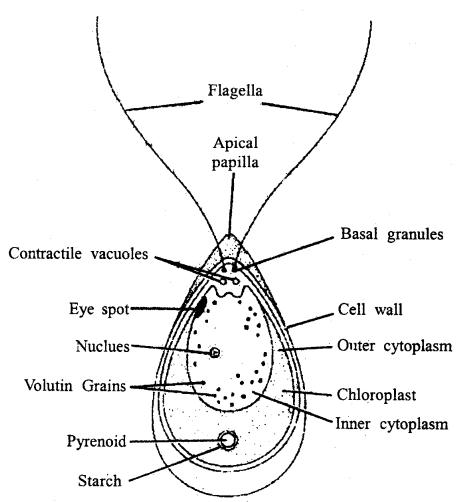
Chlamydomonas
Question 11.
Draw a neat diagram of Spirogyra.
Answer:

Spirogyra
Question 12.
Describe the fern sporophyte.
Answer:
Fem sporophyte is differentiated into root, the stem is a rhizome with adventitious roots, the young part of the rhizome has ramenta. the leaves are bipinnately compound.
Question 13.
Distinguish between Antherida and Archaegonia.
Answer:
| Antheridia | Archaegonia |
| 1. It is the male reproductive organ. | 1. It is the female reproductive organ. |
| 2. It is racket-shaped | 2. It is usually flask-shaped. |
| 3. Sterile cells are absent inside antheridia. | 3. Neck canal cells, venter canal cells form the sterile cells. |
| 4. It produces many male gametes | 4. It produces only one female gamete. |
| 5. The male gamete is usually motile | 5. The female gamete is usually non-motile. |
Question 14.
How do red algae differ from brown algae?
Answer:
Differences between red algae and brown algae:
| Red algae | Brown algae |
| 1. Unicellular and microscopic only a few are filamentous and Heterotrichous. | 1. Filaments and heterotrichous. |
| 2. Phycoerythrin, phycocyanin and phycobilins pigments are present. | 2. Fucoxanthin pigment is present. |
| 3. Reserve food material is Floridian starch. | 3. Reserve food material is Laminarian starch. |
| 4. Chlorophyll ‘a’ present. | 4. Chlorophyll ‘a’ + ‘c’ present. |
| 5. e.g. Gelidium Polysiphonia. | 5. e.g. Laminaria, Fucus and Surgaassum. |
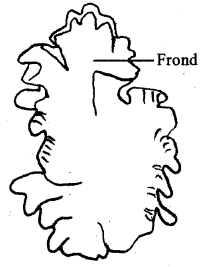
Red algae
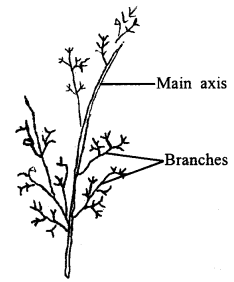
Porphyra or Polysiphonia
Question 15.
Distinguish the reproductive organs of gymnosperms and angiosperms.
Answer:
| Gymnosperms | Angiosperm |
| 1. The sporophylls are aggregated to form cones. | 1. The sporophylls are aggregated to produce flowers. |
| 2. Microporosphyll consists of micro-sporangia bearing microspores. | 2. Microsporophyll is differentiated into anther and filament. |
| 3. Stigma and style are absent. | 3. Stigma and style are present. |
| 4. Ovule lies on the lower side and exposed to the megasporophyll. | 4. Ovules are attached to the funic-ulus and are present inside the ovary. |
| 5. One too many cotyledons are present. | 5. One or two cotyledons are present. |
| 6. Fruit formation doesn’t take place. | 6. Fruit formation takes place. |
| 7. Double fertilization is absent. | 7. Double fertilization is present. |
| 8. Archaegonia are present. | 8. Archaegonia are present. |
Question 16.
Mention the changes that take place when the fruit ripens.
Answer:
- Starch is converted into sugar.
- The production of various organic substances gives it a texture, taste and flavour.
- The breakdown of chlorophyll leads to changes in the colour of the skin of the fruit.
Question 17.
What is the importance of seed?
Answer:
- The seed contains the young embryo which develops into a new plant.
- Seed can be dispersed and carried to faraway places without losing viability.
- Seed is neither the beginning nor the end of life. It is a state of suspended animation.
Question 18.
Describe the important characteristics of gymnosperms.
Answer:
Characteristic features of gymnosperms:
- Gymnosperms are evergreen woody, perennial plants.
- Plants are heterosporous.
- Reduction of gametophytic generation.
- The enclosure of the female gametophyte by the megasporangium.
- Ovules are exposed to receive pollen grains.
- Gymnosperms possess exposed or naked seeds.
- Polyembryony is a common occurrence.
- Xylem lacks vessels and phloem lacks companion cells. Example Cycas, Pinus and Cedms.
Question 19.
Name two characters Used for the classification of dicotyledons in 3 sub-classes.
Answer:
Number and nature of floral whorls. Sub-classes are divided into series mainly on the position of the ovary with respect to other floral parts.
Question 20.
Explain briefly the alternation of generation in bryophytes.
Answer:
Alternation of generations: Moss plants are a gametophyte. Spore is the beginning of the gametophytic generation. It develops into protonema which rises to male and female gametes produced in them. Club-shaped antheridium bears biflagellate sperms or antherozoids. Flask-shaped archegonium encloses the female egg. a zygote is formed after the fertilization (syngamy) of male and female gametes with the help of water.
Repeated divisions of the zygote give rise to the embryo (2n) which soon develop into a sporophyte. The sporophyte of moss gets differentiated into three parts -foot, seta and capsule. Inside the capsule, single-celled spores are produced. After the dehiscences, they begin to germinate and give rise to the protonema to start the cycle again. Gametophytic generation al¬ternates the sporophytic generation.
Question 21.
Draw the haplontic life-cycle.
Answer:
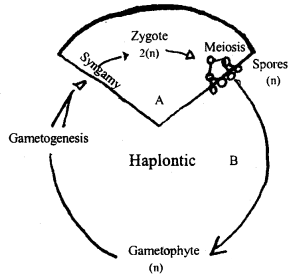
Haplontic life-cycle
Question 22.
Draw the diplontic and haplo-diplontic cycles.
Answer:
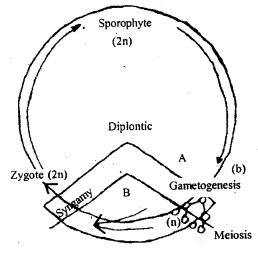
Diplontic cycles
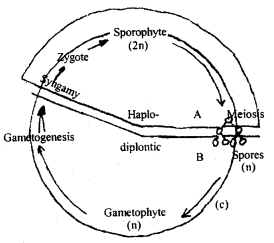
Haplo-diplontic cycles
Plant Kingdom Biology Important Extra Questions Long Answer Type
Question 1.
What are angiosperms? Give their characteristic features.
Answer:
Angiosperms are a group of flowering plants where seeds are embedded in the fruits.
They show the following characters:
- The ovules/seeds are enclosed within the ovary, or we may say that after fertilization seeds are located in the fruit.
- Male and female gametes i.e. pollen grains and egg nucleus are borne by the flowers.
- During pollination pollen grains fall on the stigma, they develop on the stigma of the ovary and male gametes enter the egg nucleus through Onicropyh.
- Male gametophyte is a three-celled structure when dehisced.
- Embryosac or female gametophyte is eight celled when young and becomes seven celled at the time of fertilization.
- There is double fertilization wherein one male gamete fuses with the egg nucleus to form a diploid zygote and another fuse with the secondary nucleus to form a triploid endosperm.
- Xylem consists of tracheids, vessels fibres and parenchyma while phloem consists of sieve tubes, companion cells and phloem parenchyma and fibres. Xylem conducts water to the tip of tall trees and phloem is responsible for the translocation of food.
Question 2.
Write brief notes on:
(i) Green algae
Answer:
Green Algae: The Class (Chlorophyta: ‘GK’ choros = green: phyton = plant) has over 7,000 species. They are in several shapes and sizes. Some are unicellular and microscopic. Some are motile colonies like Volvox. Some, are multinucleated but unicellular i.e. coenocytic like cholera.
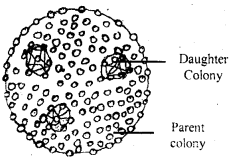
Volvox
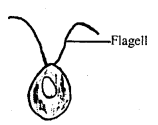
Chlamydomonas
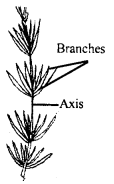
Chara
(ii) Brown algae
Answer:
Brown Algae: The Class (Phaeophyta: GK: pharos = brown: phyton = plant) has about 2,000 species, mostly marine. Some of, the world’s largest sea plants measuring 40-60 metres long. Brown algae occur chiefly in cooler seas. Some are filamentous. Brown algae like Laminaria are attached firmly to the rocks below by holdfasts.
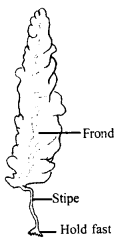
Laminaria
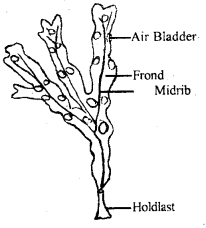
Fucus
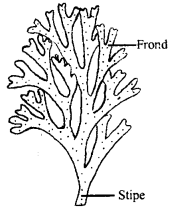
Dictyota
(iii) Club moss
Answer:
Club mass: It belongs to Lycopsida. In most parts of the world, Lycopodium is found. Sporangia’ are produced on mature leaves.
(iv) Horsetail
Answer:
Horsetail: Also called Sphenopsida. This group exists only Equisetuin. Because they look like the tail of a horse, so they are called horsetail. These plants are up to 1 metre in length. But some extinct species are of several metres. The root, stem and leaves are true.
(v) Sporophyll
Answer:
SporphyMs: They are special spore-bearing leaves and. produce sporangia in sori on their underside, where haploid spores are formed by meiosis. Spores germinate to form an independent, small gametophyte, the prothallus. This bears archegonia and antheridia. Male gamete from antheridia and swim in a film of water to egg cells in archegonia and fertilize them.
Question 3.
Discuss the development of seed habit.
Answer:
The seed plants have two kinds of sporangia. These sporangia are born on the sporophylls.
One type of sporangia are ovule or megasparangium. The other type of sporangia is the pollen sac or archegonium. The egg develops a pollen sac or microsporangium. The egg develops in the ovule from the megaspores. Many pollen grains are produced in the pollen sac.
The pollen grains are dispersed by the air! They reach the ovule. The male gamete and the female egg cell fuse together. The zygote is formed as a result of fertilization. Later on, the zygote forms the embryo. The seed is developed from the ovule. The development of seed habit in gymnosperm and angiosperm do not require liquid water during fertilization
Question 4.
What are the different lifestyles shown by Angiosperms?
Answer:
- Hydrophytic plants are the plants that live in water or swampy places. Hydrophytes are categorised into, two groups:
(a) Submerged plants like Hydrilla, Vallisneria, Utriculria and
(b) Floating plant-like Nymphea, Wolffia and Pistia. - Xerophytic plants are those plants that live in the scarcity of water e.g. cactus.
- Halophytes are a type of xerophytic plants that are present in saline conditions.
- Insectivorous plants-A few angiosperms, though green and autotrophic trap insects to overcome the shortage of nitrogen. For example, pitcher plant, sundew, bladderwort.